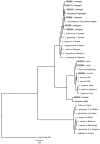Asymptomatic renal colonization of humans in the peruvian Amazon by Leptospira
- PMID: 20186328
- PMCID: PMC2826405
- DOI: 10.1371/journal.pntd.0000612
Asymptomatic renal colonization of humans in the peruvian Amazon by Leptospira
Abstract
Background: Renal carriage and shedding of leptospires is characteristic of carrier or maintenance animal hosts. Sporadic reports indicate that after infection, humans may excrete leptospires for extended periods. We hypothesized that, like mammalian reservoir hosts, humans develop asymptomatic leptospiruria in settings of high disease transmission such as the Peruvian Amazon.
Methodology/principal findings: Using a cross-sectional study design, we used a combination of epidemiological data, serology and molecular detection of the leptospiral 16S rRNA gene to identify asymptomatic urinary shedders of Leptospira. Approximately one-third of the 314 asymptomatic participants had circulating anti-leptospiral antibodies. Among enrolled participants, 189/314 (59%) had evidence of recent infection (microscopic agglutination test (MAT0 >or=1:800 or ELISA IgM-positive or both). The proportion of MAT-positive and high MAT-titer (>or=1:800) persons was higher in men than women (p = 0.006). Among these people, 13/314 (4.1%) had Leptospira DNA-positive urine samples. Of these, the 16S rRNA gene from 10 samples was able to be sequenced. The urine-derived species clustered within both pathogenic (n = 6) and intermediate clades of Leptospira (n = 4). All of the thirteen participants with leptospiral DNA in urine were women. The median age of the DNA-positive group was older compared to the negative group (p<or=0.05). A group of asymptomatic participants ("long-term asymptomatic individuals," 102/341 (32.5%) of enrolled individuals) without serological evidence of recent infection was identified; within this group, 6/102 (5.9%) excreted pathogenic and intermediate-pathogenic Leptospira (75-229 bacteria/mL of urine).
Conclusions/significance: Asymptomatic renal colonization of leptospires in a region of high disease transmission is common, including among people without serological or clinical evidence of recent infection. Both pathogenic and intermediate Leptospira can persist as renal colonization in humans. The pathogenic significance of this finding remains to be explored but is of fundamental biological significance.
Conflict of interest statement
The authors have declared that no competing interests exist.
Figures




References
Publication types
MeSH terms
Substances
Associated data
- Actions
- Actions
- Actions
- Actions
- Actions
- Actions
- Actions
- Actions
- Actions
- Actions
- Actions
- Actions
- Actions
- Actions
- Actions
- Actions
- Actions
- Actions
- Actions
- Actions
- Actions
- Actions
- Actions
- Actions
- Actions
- Actions
- Actions
- Actions
- Actions
- Actions
- Actions
- Actions
- Actions
- Actions
- Actions
Grants and funding
LinkOut - more resources
Full Text Sources

